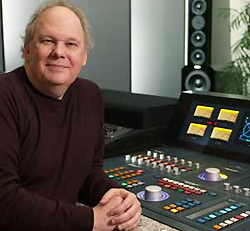
What is your opinion of the consumer electronics audio market?
It is a wide market. I admire the bang for the buck that the Apple products have when used with audiophile earbuds. The high-end continues to improve, Transparent Audio somehow makes even better cable than they did 10 years ago, and Wilson Audio is designing better and better speakers.
I wish that manufacturers would concentrate on making one or two best-price-point efforts and thus make them more affordable instead of making three or four ‘adequate, better, even better and best’ models. Time and time again I have heard well-respected transducer companies make new products that are worse than their previous product. How can that be?
Is is possible for custom installers/dealers and consumers to build a system that’s capable of approaching the performance of the equipment you use?
Yes, of course.
My monitors are bridged Cello Performance Mk. II amplifiers using Transparent Cable’s Opus Speaker Cable – and all other cables we use – and custom Eggleston Works Ivy speakers serial numbers one and two. So while my speakers were personally tweaked by William Eggleston and myself, I guess that can’t be replicated, but sure you can get close.
Some of Andy Payor’s Rockport Technology speakers are right up there, some aspects are probably better. There is no divorce between the playback of a speaker and room acoustics, so my room had a lot of detail put into it. Plus, we run the studio on giant batteries. We create our own 60 Hz sine waves so our power is as clean as possible.
With 4,000 Watts possibly coming out of the bridged Cello amps, someone can puts their ear up to the tweeter to hear that basically no sound coming out of it, and this is in a very quiet room. My eight-channel surround sound console is made by SPL in Germany with electronics using 124-volt DC rails and it is hard to find consumer gear like that. The digital gear is all readily available to whoever wants to spend the money.
Is it possible for room acoustics to negate the performance of the best gear? And, conversely, can the acoustics of a well-designed room enhance the performance of entry-level and mid-fi gear?
Totally. As I said before, my room was conceptually designed from the ground up using computer programs that actually worked. I wanted to have acoustics as near-perfect as one could have, so I knew in advance I needed a space about 20-feet high, 30-feet long and a width using one of the Louden ratios.
So when I started my business, I looked only at spaces that could accommodate that space. It also has the world’s first third-generation Diffractal acoustical products that do amazing things for the acoustics but the products are very expensive. Buying a speaker without also buying room acoustic correction devices is foolhardy.
Do you typically use a set process or does the genre, artist, time and money affect how you master a record?
When I hear a raw tape from the mix room, I imagine in my head what it could sound like, and I move the knobs of the gear to make it sound like it does in my head. Sometimes a mix is so far off it may need to be remixed and remastered again.
I have no rules. Sometimes I’ll hear something and instantly know that a piece of gear I hadn’t used in five years would be the perfect thing for that music. A lot of times it is important to be surrounded with a lot of expensive gear and to choose to use none of it because it isn’t needed.
Without hearing the master mixes, it is impossible to tell what the contribution of the mastering engineer was to the process. All you can do is say, “I’ve heard a lot of records with so-and-so’s name on it and they usually sound good … he must be good.” As I’ve said, my job is to assist the artist in presenting their vision of their music to the public and sometimes they want some ugly sounding stuff.
